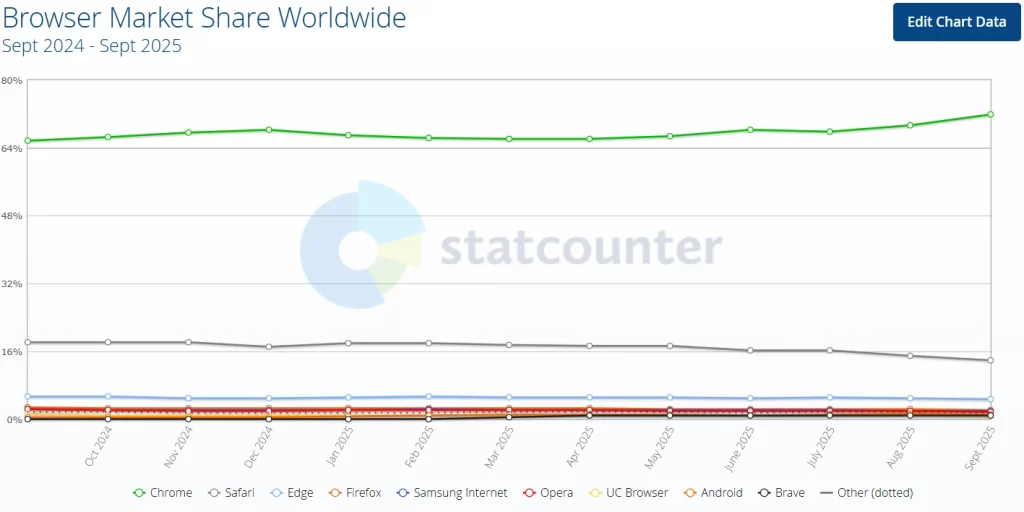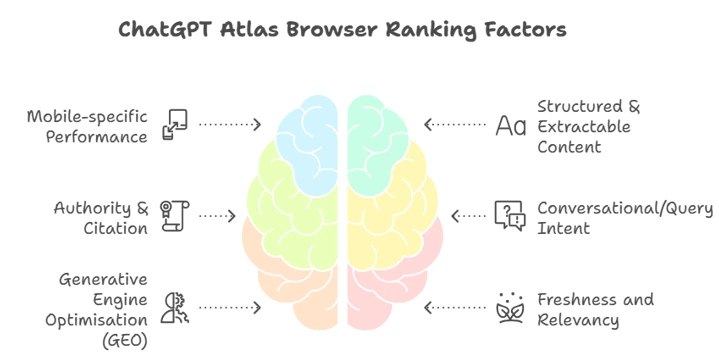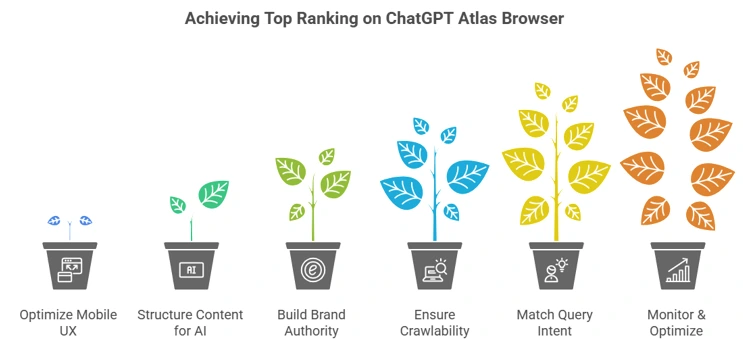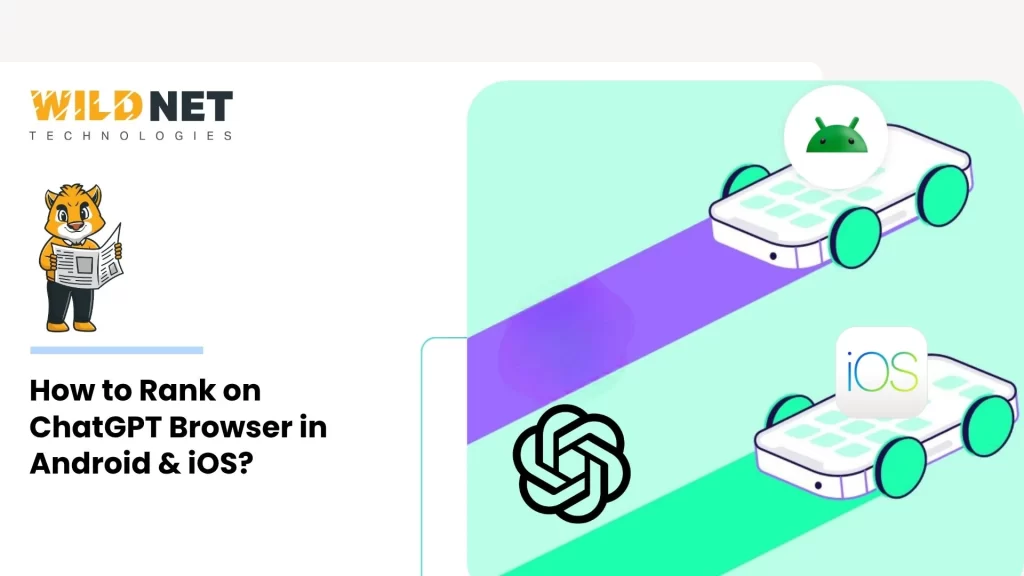Summary
ChatGPT Atlas browser is here, and brands & their marketers have a new challenge.
It will require heightened mobile-friendliness and AI-friendly website content, which various brands have yet to achieve.
Wildnet is here with its latest newsletter to debunk the fears that come with a new AI browser.
Key Takeaways
- The ChatGPT Atlas Browser integrates an AI assistant directly into the browsing experience—meaning the rules for visibility and ranking are changing.
- Content designed for Android & iOS mobile users must be faster, more structured, conversational and optimized for “AI browser ranking”.
- To rank effectively on ChatGPT Atlas Browser, you need to combine mobile-first UX, structured data, brand authority, and fresh content tailored to mobile query intent.
- Monitoring and adapting to GEO (generative engine optimization) signals will be crucial as the ChatGPT Atlas Browser ecosystem expands.
Table of Contents
- A few facts about ChatGPT Atlas
- What is the ChatGPT Atlas Browser?
- How does Ranking on ChatGPT Atlas Browser work?
- Actionable Steps to Rank on ChatGPT Atlas Browser (Android & iOS)
- How to Future-Proof Your Content Strategy for a Mobile-First Approach?
- Conclusion
- FAQs
Browsers are evolving in a mobile-first world. The new ChatGPT Atlas Browser from OpenAI puts a conversational AI assistant at the heart of browsing rather than just a search engine on top.
For marketers and content creators, this means the race isn’t just about ranking in Google —it’s about being visible inside an AI-driven mobile experience.
To rank on ChatGPT Atlas Browser on Android & iOS, you’ll need a fresh mindset and a mobile-centric plan brought to you by our Digital Yum.
A few facts about ChatGPT Atlas
- ChatGPT Atlas was launched on 21st Oct 2025.
- It is currently available on macOS only.
- ChatGPT Atlas Browser is Free to use across the globe.
- Perplexity AI has already launched its own AI browser, Comet.
- Google is working on an AI browser, as they do not wish to lose their supremacy in search.

Global Browser Usage Stats – Sep 2024-2025 [Source: Statcounter]
What is the ChatGPT Atlas Browser?
The ChatGPT Atlas Browser is an AI-native browser built on Chromium. It was initially released for macOS, and future versions of Windows and mobile (Android and iOS) are promised.
What sets it apart from the rest?
Its key features, such as the ones listed below, set it apart from the competition.
- A persistent “Ask ChatGPT” sidebar that allows users to ask questions about the page they’re on, get summaries, or delegate tasks.
- “Browser memories” that, when enabled, let the assistant remember visited pages and browsing behaviour to personalise interactions.
- Purpose-built for task completion (shopping, research & summarising) rather than just navigating to links.
From a visibility standpoint, the ChatGPT Atlas Browser shifts how content is discovered and surfaced. It’s less about keyword matching & more about how well the AI assistant can use your mobile-friendly and structured content.
When you plan to rank on ChatGPT Atlas Browser, you prepare for this new kind of visibility.
How does Ranking on ChatGPT Atlas Browser work?

6 Ranking Factors for ChatGPT Atlas
Ranking on the ChatGPT Atlas Browser differs from classic search engine ranking in several important ways. Here’s how it works, and what you should focus on.
Key Ranking Signals for ChatGPT Atlas
Mobile-specific Performance
Because browsing on Android & iOS is essential, the ChatGPT Atlas Browser will prioritise content that loads fast, uses mobile-friendly layout and delivers smooth UX.
Structured & Extractable Content
The assistant needs to parse and summarise your content, so formatting (headings, bullets & FAQs) and schema markup become critical to help enable “AI browser ranking”.
Authority & Citation
Instead of just links and backlinks, the AI emphasises trusted sources, brand mentions, and consistent visibility across mobile platforms—so brand authority matters.
Conversational/Query Intent
Mobile users will use natural-language prompts (“What’s the best…”, “How do I…” & so on) and the ChatGPT Atlas Browser will favour content that aligns with that style.
Generative Engine Optimisation (GEO)
You’re optimising not just for search results but also for the AI assistant’s ability to choose and cite your content in mobile interactions.
Freshness and Relevancy
Because the ChatGPT Atlas Browser supports deep tasks and interactions, content that stays up-to-date & relevant to mobile enquiry contexts is more likely to be surfaced.
In short, your mobile SEO strategy must evolve into a mobile-AI-browser ranking strategy to rank on ChatGPT Atlas Browser.
Actionable Steps to Rank on ChatGPT Atlas Browser (Android & iOS)
Here are practical steps you can implement now to prepare your site and content for ranking on the ChatGPT Atlas Browser.

Six Steps to Rank on ChatGPT Atlas Browser
a) Optimise Mobile UX & Performance
- Ensure your site is fully responsive and delivers excellent performance on Android & iOS (fast load times, minimal render-blocking & efficient images).
- Use mobile-first design patterns, reduce mobile bounce & optimise for touch interactions.
- Consider (progressive web app) PWA or app-like functionality in your website for mobile users, to align with the seamless experience the ChatGPT Atlas Browser targets.
b) Structure Content for AI Extraction
- Lead with a clear & concise answer at the top, then expand with supporting detail — this helps the assistant capture key points quickly.
- Use headings (H2, H3), bullet lists and FAQs — especially for mobile users to skim and for the AI to summarise.
- Apply schema markup such as HowTo, FAQ or Q&A to enhance structured extraction.
- Write conversationally, matching expected mobile queries such as “How do I optimise my website for ChatGPT Atlas Browser on iOS?”.
c) Build Brand Authority & Credible Mobile Presence
- Get mentions and citations from authoritative mobile-friendly sites, especially ones that rank well for mobile SEO.
- Ensure your brand presence is consistent across mobile platforms (app store listings, mobile web & responsive site).
- Encourage reviews, mobile citations, and social mentions — the ChatGPT Atlas Browser may source these for trust signals.
d) Ensure Crawlability & Accessibility for AI Bots
- Confirm your mobile URLs are indexable & not blocked in robots.txt (no mobile-only errors).
- Provide a mobile sitemap and ensure canonical tags are mobile-appropriate.
- On Android & iOS versions, test site performance in high-latency and low-network conditions (since mobile users vary).
- Ensure metadata, structured data, and content are accessible to AI crawlers.
e) Match Mobile Query Intent & Keep Content Fresh
- Analyse actual mobile user intents (“Best way to do X on iOS” & “Android mobile SEO for AI browser”) and build content around those.
- Update your mobile content regularly and include “last updated” timestamps to signal freshness.
- Address mobile-specific contexts: smaller screens, voice queries & app vs web trade-offs.
f) Monitor & Optimise for Mobile AI Browser Engagement
- Test how your content appears when accessed via Android and iOS devices (as soon as ChatGPT Atlas Browser is available) to see if the AI surfaces, cites, or uses it.
- Track mobile-specific metrics (mobile page speed, mobile bounce & time on site) separately and optimise for them.
- Use analytics segments for mobile traffic, and observe if mobile quest/granular queries drive engagement — adjust content accordingly.
If you consistently implement these steps, your brand/client will be in a strong position to rank on ChatGPT Atlas Browser when respective versions roll out, giving you a competitive mobile-first edge.
How to Future-Proof Your Content Strategy for a Mobile-First Approach?
Looking ahead: The ChatGPT Atlas Browser is built for mobile contexts (Android & iOS) and interactive AI use. So, you’ll want to future-proof your strategy accordingly.
- Build mobile-first content now: Prepare for the Android & iOS rollout of ChatGPT Atlas Browser by ensuring your mobile UX, content structure, and mobile-query targeting are ready.
- Use multimedia that suits mobile: the AI assistant may surface short videos, infographics, and interactive elements in the browser.
- Optimise for voice and conversational queries: Many mobile users will speak into the assistant rather than type traditional search queries.
- Think of “content as answer”: The ChatGPT Atlas Browser is less about linking and giving immediate answers — create content that fits that paradigm.
- Watch for ecosystem shifts: As mobile AI browser usage grows, ranking signals and user behaviours may change — stay agile & iterate your mobile strategy.
We know it’s not something a brand can do alone, so start looking for an AI Marketing agency.
Conclusion
The launch of the ChatGPT Atlas Browser transforms mobile web interaction and brand visibility.
To rank well on this browser for Android and iOS, adopt a mobile-first, AI-driven, conversational content strategy, emphasizing brand authority and mobile-friendly design.
Optimizing for mobile AI ranking now will enhance your position as the ChatGPT Atlas Browser grows in popularity, making your mobile site and content structure crucial for success.
Don’t fret, we got you…
Wildnet Technologies is a leading digital marketing company in India that is also an AI-first company.
Wish to know more?
> ChatGPT SEO vs. Traditional SEO: Who Wins the SEO Battle?
> What AI Means for SEO in 2026: Trends to Watch Now
> Glossary (Jargons that keep you Looped)
Contact us now at info[@]wildnettechnologies.com and become ChatGPT Atlas Browser ready.
FAQs
Question 1: When will the ChatGPT Atlas Browser be available on Android & iOS?
Answer 1: The browser launched initially on macOS, with Windows, Android, and iOS versions listed as “coming soon.” So, the time to be ready for it is now, not when all the versions are out.
Question 2: Does ranking on ChatGPT Atlas Browser mean traditional SEO is obsolete?
Answer 2: No — traditional SEO remains essential. But ranking on ChatGPT Atlas Browser requires additional mobile-first and AI-aware optimisation (GEO) steps beyond classic SEO.
In short, a brand needs to do more SEO, which gets upgraded almost every month.
Question 3: How should I prioritise mobile vs desktop in this strategy?
Answer 3: Prioritise mobile (Android & iOS) because the ChatGPT Atlas Browser emphasises mobile experiences, conversational queries, and UX. Once the mobile strategy is solid, adapt the desktop accordingly because we all surf the net on mobiles and open our laptops only when needed.
Question 4: Can I measure performance specific to ChatGPT Atlas Browser today?
Answer 4: Not fully yet — as the browser rollout is still early. But you can track mobile metrics (page speed, bounce & mobile time-on-site) and test your content visibility on mobile test devices.
Question 5: What does “Generative Engine Optimization (GEO)” mean?
Answer 5: GEO refers to optimising your content for AI assistants and AI browsers (like ChatGPT Atlas Browser) rather than only traditional search engines. It emphasises structure, clarity, conversational tone and mobile suitability.







